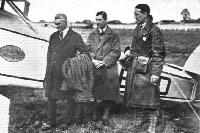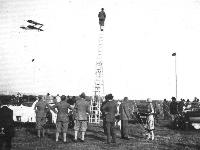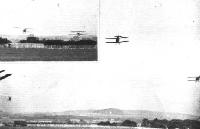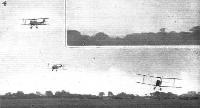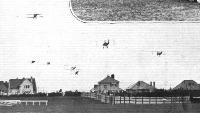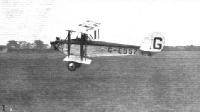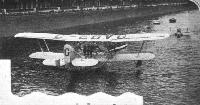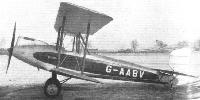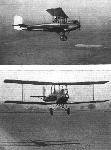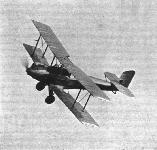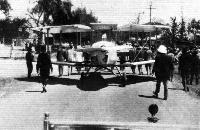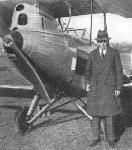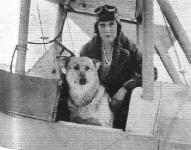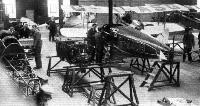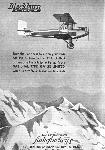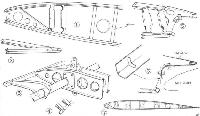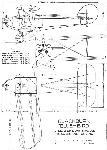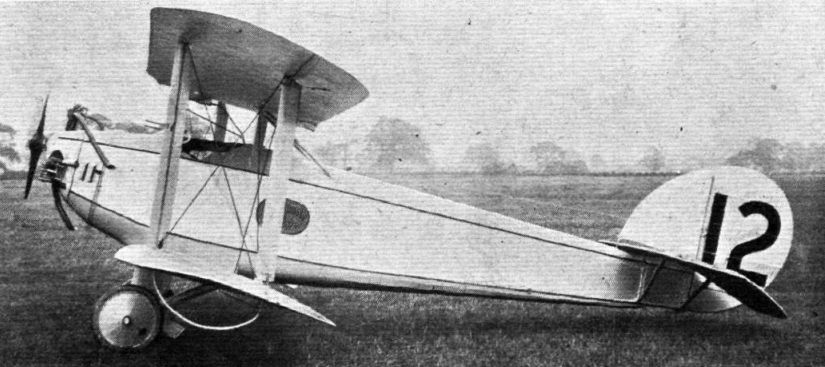
Blackburn L.1 Bluebird
Запущенный в серийное производство в 1927 году, деревянный биплан L.1 Bluebird имел уникальное для английских легких двухместных самолетов размещение экипажа - бок о бок. Прототип L.1 был построен для участия в проводившихся Министерством авиации в 1924 году испытаниях легких самолетов в Лиме. Он был оснащен мотором воздушного охлаждения Blackburne Thrush с объемом цилиндров 1100 см3. Машину не успели закончить в срок, но в дальнейшем она получила новый двигатель Armstrong Siddeley Genet мощностью 60 л.с (45 кВт) и должна была участвовать в конкурсе, проводившемся в сентябре 1926 года. К сожалению, и на этот раз Bluebird остался в стороне из-за проблем с шасси. Полоса неудач закончилась несколько дней спустя, когда самолет выиграл гонки на кубок Гросвенор, показав скорость 137 км/ч. Машина успела выиграть еще одну гонку, прежде чем в июне 1927 года была потеряна в катастрофе - столкновении в воздухе.
Первые 13 серийных самолетов, получивших обозначение L.1A Bluebird II, были оснащены моторами Genet II мощностью 80 л.с. (60 кВт) и поставлялись аэроклубам в Восточной Англии и Йоркшире. Один экземпляр, построенный по спецзаказу, был оснащен поплавковым шасси и получил широкую известность благодаря полетам вдоль побережья Англии. Два Bluebird II были проданы в Бразилию.
Самолет L.1B Bluebird III появился в 1927 году. Первую машину этого типа переделали из 14-го серийного Bluebird II - полотно обшивки хвостовой части заменили на фанеру, а в центроплане верхнего крыла установили топливный бак. После демонстрационного турне по различным городам на самолет установили двигатель ADC Cirrus III мощностью 90 л. с. (67 кВт). Была заложена серия из шести Bluebird III с моторами Genet мощностью 60 л. с. (45 кВт), но последний самолет так и не был достроен.
Последняя модификация, L.1С Bluebird IV, появившаяся в 1929 году, имела полностью переработанную конструкцию и лишь внешним видом напоминала предшественников. Из-за возросших требований к мощности силовой установки самолеты этого семейства оснащались различными типами двигателей. Загруженная военными заказами компания "Blackburn" первоначально смогла построить лишь три Bluebird IV. Выпуск 55 самолетов был поручен фирме "Saunders-Roe" с острова Уайт, но, фактически, последние 20 машин были достроены "Blackburn".
У самолетов Bluebird IV была интересная судьба - многие из них участвовали в дальних перелетах, наиболее заметным из которых сал преподносившийся как первый в мире кругосветный перелет на легком самолете. Его совершила миссис Милдред Брюс в период с 25 сентября 1930 по 20 февраля 1931 года. Однако следует отметить, что участки маршрута Токио - Сиэтл и Нью-Йорк - Гавр путешественница преодолела на борту корабля. Последний сохранившийся Bluebird, 11-я серийная машина, пошел на слом в 1947 году.
ТАКТИКО-ТЕХНИЧЕСКИЕ ХАРАКТЕРИСТИКИ
Blackburn L.1C Bluebird IV
Тип: двухместный туристический самолет
Силовая установка: один двигатель жидкостного охлаждения de Havilland Gipsy I мощностью 100 л. с. (75 кВт)
Летные характеристики: максимальная скорость 166 км/ч у земли; крейсерская скорость 138 км/ч на оптимальной высоте; скороподъемность у земли 219 м/мин; дальность полета 756 км
Масса: пустого 472 кг; максимальная взлетная 794 кг
Размеры: размах крыла 9,14 м; длина 7,06 м; высота 2,74 м; площадь крыльев 25,08 м1
Описание:
- Blackburn L.1 Bluebird
- Flight, September 1924
THE BLACKBURN "BLUEBIRD" LIGHT BIPLANE (No. 12) - Flight, September 1926
British Light ‘Plane Development & Lympne Meeting - Flight, December 1927
BLACKBURN "BLUEBIRD" Mk. II - Flight, October 1928
British Exhibits At The Berlin Aero Show 1928 - Flight, January 1929
THE BLACKBURN "BLUEBIRD" MARK IV - Flight, June 1929
BRITISH AIRCRAFT AT OLYMPIA - Flight, April 1930
AIRCRAFT FOR THE PRIVATE OWNER
Фотографии
-
Flight 1924-10 / Flight
TOO LATE FOR LYMPNE: The Blackburn "Bluebird" with Blackburne engine was not finished in time to take part in the recent two-seater light 'plane competitions.
-
Flight 1925-04 / Flight
Регистрационный номер: G-EBKD [8] THE BLACKBURN "BLUEBIRD" LIGHT 'PLANE: Three-quarter rear view. Note the door giving access to the cockpit.
-
Aeroplane Monthly 1982-05 / G.Todd - Rover's Return
Регистрационный номер: G-EBKD [8] TWO BLACKBURN SCHOOL MACHINES: On the left, the "Dart" seaplane, with Napier "Lion" engine; and on the right, the "Bluebird" light 'plane, with Blackburne engine.
The two-seat Blackburn Dart seaplane G-EBKF, and the prototype Blackburn Bluebird, G-EBKD at Brough early in 1925.Другие самолёты на фотографии: Blackburn Swift T.1 / Dart T.2 - Великобритания - 1920
-
Aeroplane Monthly 1982-05 / G.Todd - Rover's Return
Регистрационный номер: G-EBKD [8] The prototype Bluebird on the Brough compass base in January 1925.
-
Flight 1925-04 / Flight
Регистрационный номер: G-EBKD [8] The Blackburn "Bluebird": In this view the undercarriage and the engine cowling, etc., are clearly shown. Note the Fairey-Reed Duralumin propeller.
-
Flight 1926-09 / Flight
No. 1. THE BLACKBURN "BLUEBIRD": Side View.
-
Flight 1926-09 / Flight
ELIMINATED: The Blackburn "Bluebird" damaged slightly its undercarriage and permission to effect repairs was refused.
-
Flight 1927-04 / Flight
Регистрационный номер: G-EBKD [8] The "Target": The Blackburn "Bluebird" with Armstrong-Siddeley "Genet" which was fired at and hit with a shot gun. The perpetrator of this attack has since been arrested.
-
Flight 1927-04 / Flight
Регистрационный номер: G-EBKD [8] Examining the Target: Squadron Leader Longton, Mr. Thornton and Mr. Ely of the Blackburn Co., having a look at the pellet holes with which the "Bluebird" was perforated.
-
Flight 1926-09 / Flight
"BLACKBIRDERS" AT THE LANCASHIRE AIR PAGEANT: Mr. B. Flinton, Squadron-Leader Longton, D.F.C., A.F.C., Mr. A. C. Thornton, designer, under Major Bumpus, of the Blackburn "Bluebird," and Mr. Norman Blackburn.
-
Flight 1928-08 / Flight
Регистрационный номер: G-EBTB When a customer demanded a Morris Six Coupe immediately Mr. A. G. Wilson, of Leeds, flew to Oxford in this Blackburn "Bluebird" from Sherburn, Yorkshire, and delivered the car in Leeds by the evening, earlier than promised.
-
Flight 1928-04 / Flight
Регистрационный номер: G-EBSZ [3] EASTER AT HADLEIGH: Here are seen the light aeroplanes parading past the crowd on Monday afternoon. Two Westland "Widgeons'' are leading and the Blackburn "Bluebird" is following up. The public was able to make a thorough study of all the light aeroplane types at present on the market, for each type was represented in numbers.
Другие самолёты на фотографии: Westland Widgeon - Великобритания - 1924
-
Flight 1927-08 / Flight
SOME STARTERS IN THE KING'S CUP RACE: D. A. N. Watt gets away on his "Avian." In the background, the Blackburn "Bluebird" and the Westland "Widgeon III" waiting to start.
Другие самолёты на фотографии: Avro Avian / Type 594/616 - Великобритания - 1926Westland Widgeon - Великобритания - 1924
-
Flight 1928-07 / Flight
The photograph shows the Blackburn "Bluebird" with Armstrong-Siddeley "Genet" engine. The machine is a light 'plane, but is unusual in that pilot and passenger sit side by side.
-
Flight 1927-03 / Flight
SOME OF THE MACHINES AT NORWICH: The Blackburn "Bluebird" with Armstrong-Siddeley ''Genet'' engine does a ''zoom.''
-
Flight 1926-09 / Flight
"OVER THE STICKS": This photograph gives a good idea of the manner in which the take-off tests were observed. On the ladder is Major Buchanan, of the Air Ministry, while among those in the foreground may (or may not) be recognised Major Mayo, Lieut.-Col. Sir Francis McClean, and Mr. C. C. Walker. The machine "going over the top" is the Blackburn "Bluebird," piloted by Squadron-Leader Longton.
-
Flight 1928-04 / Flight
Suffolk Club's Air Race: There was a good race for the Suffolk Handicap over a course of 21 miles on Monday afternoon. Five machines entered, and in this picture we see the Blackburn "Bluebird," flown by Capt. Blake, getting well away 2 mins. 22 secs, after Miss Spooner, who won the race. Capt. Blake unfortunately got confused with the turning points and, therefore, came in fourth.
-
Flight 1927-08 / Flight
THE NOTTINGHAM FLYING MEETING: Col. The Master of Sempill on the Blackburn "Blue Bird" in heat 1 of the Pelham Stakes.
-
Flight 1927-06 / Flight
Регистрационный номер: G-EBKD [8] THE PRIVATE OWNERS' HANDICAP: Longton making a turn on the Blackburn "Bluebird."
-
Flight 1927-04 / Flight
Регистрационный номер: G-EBKD [8] GOOD HAND: Longton on the Blackburn "Bluebird."
-
Flight 1926-09 / Flight
Winning the Grosvenor Cup Race: Longton, on the Blackburn "Bluebird" with Armstrong-Siddeley "Genet" engine crossing the finishing line. His average speed was 84-95 m.p.h.
-
Flight 1929-04 / Flight
Регистрационный номер: G-EBUH BOMBING AN AUSTIN SEVEN: Mr. G. E. Lowdell on the Blackburn "Bluebird" (Genet) bombing the Austin Seven with flour bags at the Lympne meeting. He registered two direct hits.
-
Flight 1929-09 / Flight
Регистрационный номер: G-EBRE [2] HADLEIGH AERODROME FROM THE AIR: The Club's Bluebirds in formation.
-
Flight 1926-10 / Flight
A reminiscence of the Lancashire Pageant: Sq.-Ldr. Longton "crazy-flying" on the Blackburn "Bluebird."
-
Flight 1927-05 / Flight
THE HAMPSHIRE AIR PAGEANT: Event 6, the President's Cup Race. Longton on the Blackburn "Bluebird."
-
Flight 1926-09 / Flight
THE RACE FOR THE GROSVENOR CHALLENGE CUP: No less than 21 machines faced the starter for this race, a record number. The result was that machines frequently got bunched together at the turning points. Our photograph show one of some such incidents. 2, shows the wing tips of the Cranwell, the Hawker "Cygnet," the Blackburn "Bluebird," and one of the D.H. "Moths" heading for the Postling turning point.
Другие самолёты на фотографии: Comper Cranwell IV / CLA.4 - Великобритания - 1926De Havilland Genet Moth - Великобритания - 1926Hawker Cygnet - Великобритания - 1924
-
Flight 1927-09 / Flight
Регистрационный номер: G-EBSV [3] HOOTON AIR PAGEANT: (4) Mrs. Eliott-Lynn on Avian "QL" (left), Mr. Fielding on Bluebird "SV" (middle), and Mr. Lacayo on Moth "MF" (right) coming in at the end of the first lap in Inter-Club Members' Race.
Другие самолёты на фотографии: Avro Avian / Type 594/616 - Великобритания - 1926De Havilland Moth / D.H.60 - Великобритания - 1925
-
Flight 1927-06 / Flight
AN ILL-FATED EVENT: The first race on Whit Monday was a Medium Power Handicap. In the photo some of machines are seen leaving aerodrome on the last lap. Longton on the "Bluebird" is seen in the top left-hand corner.
Другие самолёты на фотографии: De Havilland Moth / D.H.60 - Великобритания - 1925
-
Flight 1927-06 / Flight
THE PRIVATE OWNERS' HANDICAP: The machines are here seen approaching the aerodrome turning point at the conclusion of the second lap. Mr. Norman Jones was so far ahead as to be out of the picture. The others are, in the order given - Longton, on the "Bluebird," de Havilland on "Moth" NO, Col. Sempill on D.H. 51, Hinkler on his "Avian," Lady Bailey on her "Moth," PU, and Scroggs on the Westland "Woodpigeon."
Другие самолёты на фотографии: Avro Avian / Type 594/616 - Великобритания - 1926De Havilland D.H.51 - Великобритания - 1924De Havilland Moth / D.H.60 - Великобритания - 1925Westland Wood Pigeon - Великобритания - 1924
-
Flight 1928-05 / Flight
Регистрационный номер: G-EBSZ [3] AT HAMBLE: Mr. Lowdell on the Blackburn "Bluebird" "SZ" is seen leading Flt.-Lieut. Rose on the D.H. "Moth" "LW".
Другие самолёты на фотографии: De Havilland Moth / D.H.60 - Великобритания - 1925
-
Flight 1929-06 / Flight
"ARAB ATTACK": Dr. J. Sleigh down in the "desert" with his "Bluebird," menaced by the "Arabs." Flt. Lieut. T. Rose dives to his assistance in the Gipsy-Moth (left), then two Blackburn "Bluebirds" ("Genets") come to complete the defeat of the "enemy."
Другие самолёты на фотографии: De Havilland Gipsy Moth / Moth X - Великобритания - 1928
-
Aeroplane Monthly 1982-12 / Hanworth /Gone but not forgotten/ (14)
A formation of Blackburn Bluebirds flying over the Hanworth club house in January 1930.
-
Flight 1936-04 / Flight
ELIMINATING TRIALS AT LYMPNE: 5, Longton planting the Blackburn "Bluebird" in the landing test.
Representative type of the pre-1926 "ultra-light" era: Blackburn Bluebird (75 h.p. 6-cyl. Genet) - the first side-by-side two-seater light aeroplane -
Flight 1927-11 / Flight
Регистрационный номер: G-EBSZ [3] SUFFOLK CLUB'S AIR DAY: (1) The Club's own Blackburn "Bluebird" is seen taking off.
-
Flight 1927-10 / Flight
Регистрационный номер: G-EBSV [3] BRISTOL CLUB'S MEETING: The Blackburn "Bluebird" in which Sir Sefton Brancker flew down from London, piloted by Capt. Stockbridge.
-
Flight 1927-10 / Flight
Регистрационный номер: G-EBSV [3] BRISTOL CLUB'S AIR DAY: These are two general views of the machines which took part at the meeting at Filton, giving an idea of how representative the machines were of the light aeroplane class.
Другие самолёты на фотографии: De Havilland Moth / D.H.60 - Великобритания - 1925Westland Widgeon - Великобритания - 1924
-
Flight 1929-02 / Flight
HADLEIGH AERODROME, SUFFOLK: The new clubhouse (right) and large new hangar which have been erected at Hadleigh Aerodrome by the Suffolk and Eastern Counties Aeroplane Club. Two of the Club's Blackburn "Bluebirds" (Armstrong-Siddeley "Genet" engines) are in the background.
-
Flight 1928-10 / Flight
Регистрационный номер: G-AABB Side by Side: The Blackburn "Bluebird," although placed under the gallery, is very effectively displayed, and its "sociable" seating arrangement is favourably commented upon.
-
Flight 1927-12 / Flight
NOVEL PUBLICITY: This is a Blackburn "Bluebird Mk.II" (Genet engine) on show in the motor showrooms of Francis E. Cox, Automobile Engineer, Leeds. It attracted the keenest public interest, for thousands viewed it during the ten days' exhibition. A number of new members were enrolled in the Yorkshire Aeroplane Club, whilst a few enquiries received may develop into sales. It is interesting to note, too, that the showing of this light aeroplane materially stimulated interest in the Essex and Wolseley cars in the same rooms.
-
Flight 1927-11 / Flight
A "BLUEBIRD" ON TOUR: During the past week Mr. Charles H. Blackburn and Lieut. A. M. Blake have been making a demonstration tour of Southern England on one of the new Blackburn "Bluebird II" machines with Armstrong-Siddeley "Genet" engine. Side-by-side seating is a feature of this machine. Note the door in the side of the fuselage.
-
Flight 1929-02 / Flight
SUFFOLK AND EASTERN COUNTIES AEROPLANE CLUB: In the group on the left are (left to right) Mrs. H. L. Billinton, Mrs. James C. Sleigh, Mrs. Courtney N. Prentice and Mr. Courtney N. Prentice. On the right are (left to right) Mr. G. E. Lowdell, A.F.M. instructor pilot, Mr. H. L. Billinton, a director, and Maj. P. L. Holmes, D.S.C., the secretary. In the centre picture is Dr. James C. Sleigh, the chairman. The machines are Blackburn "Bluebirds" (Armstrong-Siddeley "Genet" engines).
-
Flight 1928-04 / Flight
PERSONALITIES AT HADLEIGH: Miss Sylvia Edwards, the Club's first lady soloist, who demonstrated the Blackburn "Bluebird."
-
Flight 1928-04 / Flight
A CELEBRITY AT HADLEIGH: The crowd at the Hadleigh Air Meeting was pleased by the presence of Flt.-Lt. S. N. Webster, the winner of the last Schneider Trophy, who visited the aerodrome both days. He helped the Suffolk Club most effectively by doing joyriding in the Blackburn "Bluebird." For the honour of accompanying him the public paid double the normal charge.
-
Flight 1928-05 / Flight
Регистрационный номер: G-EBWE [2] SOME BLACKBURN AEROPLANES "ON PARADE": Left to right, a "Cirrus-Bluebird," a "Genet-Bluebird," a "Lynx-Lincock," a "Napier" Ripon, and a "Napier-Dart."
Другие самолёты на фотографии: Blackburn Lincock / F.2 - Великобритания - 1928Blackburn Ripon / T.5 - Великобритания - 1926Blackburn Swift T.1 / Dart T.2 - Великобритания - 1920
-
Jane's All the World Aircraft 1980 / Encyclopedia of Aviation - Aircraft A-Z - v2
Регистрационный номер: G-EBWE [2] Blackburn L.1B Bluebird III.
-
Aeroplane Monthly 1999-06 / P.Mann - Personal album /Inter-war civil/
Регистрационный номер: G-EBRE [2] "BLUEBIRD" DEVELOPMENT: This latest model of the Blackburn "Bluebird" (Genet engine) embodies improvements suggested after experience with the Mark I machine. It is adaptable to both land and sea chassis, the two pontoons being constructed of duralumin and supported by a steel tubular structure attached to the same fuselage fittings as used for the land chassis. A land type is now touring England with Mr. Charles Blackburn in charge.
The Suffolk and Eastern Counties Aero Club at Hadleigh, near Ipswich, had five Blackburn Bluebird IIs with 80 h.p. Genet II engines. G-EBRE is seen here in its original colours; it was eventually repainted, but lasted less than 2 1/2 years before being damaged beyond repair at Hadleigh on January 6, 1930.
-
Мировая Авиация 56
Регистрационный номер: G-EBSW [6] Помимо дюралевых поплавков, один Bluebird II также получил металлический винт Fairey-Reed, лучше подходивший для полетов с воды, чем деревянный.
The Blackburn Bluebird II floatplane G-EBSW was fitted with floats for the Master of Sempill in July 1928 and he flew it from the Humber to the Welsh Harp at Hendon in 4 3/4 hr. He later gave other demonstrations around the British coastline and in December that year flew to the Berlin Air Show, landing on the Wannsee. Later converted to a landplane, it was withdrawn from use at Whitchurch in December 1933. -
Flight 1928-12 / Flight
Регистрационный номер: G-EBSW [6] SEAPLANING: Col. The Master of Sempill racing a Blackburn "Bluebird" light seaplane over the Welsh Harp, Hendon, in competition with an outboard motor-boat. He has toured Great Britain and flown the North Sea in this seaplane.
-
Flight 1929-05 / Flight Advertisements
Регистрационный номер: G-EBSW [6] -
Flight 1928-08 / Flight
Регистрационный номер: G-EBSW [6] One of the sights of London last week was the all-metal Short "Calcutta" flying-boat of Imperial Airways, which, piloted by Mr. Lankester Parker, and with Mr. Oswald Short on board, flew from Rochester on August 1 and alighted on the Thames above Lambeth Bridge. It was moored opposite the Houses of Parliament, and later a large number of members, including Sir Samuel Hoare, were taken out to the flying-boat and made a thorough inspection of this latest example of modern transport. Large crowds had gathered on the embankment and the bridge to see the "Calcutta," which continued to attract sightseers during the several days it was moored on the water. Shortly after its arrival at Westminster, Col. the Master of Sempill arrived on a Blackburn "Bluebird" seaplane, which provided a striking contrast when moored next to the "Calcutta" as shown in our illustration.
Другие самолёты на фотографии: Short Calcutta / Rangoon / S.8 - Великобритания - 1928
-
Flight 1929-01 / Flight
Регистрационный номер: G-EBSW [6] These are views of the rescue of Col. the Master of Sempill's Blackburn "Bluebird" light seaplane from the grip of the ice, 3/4 in. thick, which covered the Welsh Harp at Hendon in December last. Wheels were attached after the beaching, and the machine was run up the Edgware Road to Hendon. Col. the Master of Sempill is a devotee of the light seaplane, and he always extols its use, particularly for Great Britain.
-
Flight 1929-09 / Flight Advertisements
Blackburn "Bluebird," fitted Cirrus or Gipsy engine.
-
Aeroplane Monthly 1989-01 / Personal album. Civil
Регистрационный номер: G-AABV [2] The prototype Blackburn Bluebird IV, fitted with a Gipsy I, awaiting the start of the 1930 King's Cup. Built in 1929, 'BV was flown to South Africa from Croydon during March and April that year but returned to the UK in time to be exhibited at the 1929 Aero Show, held at Olympia in July. The aircraft’s short life ended when it crashed at Hedon Aerodrome, Hull on March 6, 1934. Norman Blackburn flew 'BV in the race but was forced to retire and was unplaced.
-
Flight 1929-05 / Flight
Регистрационный номер: G-AABV [2] Although this new all-metal Blackburn "Bluebird" with D.H. "Gipsy" engine had not completed full experimental trials, Sqdr.-Ldr. L. H. Slatter flew it from London to South Africa in five weeks with scarcely any hitch.
-
Flight 1930-08 / Flight
Регистрационный номер: G-AAJC A Bluebird (Gipsy I) which Capt. Roxborough Smith is flying for the Rhodesian Aviation Company. Flights over the Victoria Falls are very popular in this machine, especially for those on their first flight, as the side-by-side seating makes conversation easy.
-
Flight 1930-05 / Flight
Регистрационный номер: G-AATS -
Flight 1932-08 / Flight
FLYING HOME: Lt. Com. G. A. Hall, of the Royal Australian Navy, about to leave Croydon for Australia in a Blackburn "Bluebird" ("Hermes II") on August 8. He has been doing duty in England on an Aircraft Carrier, and is now flying back "away under" in easy stages, without any intention of beating records for the journey.
-
Flight 1929-04 / Flight
Регистрационный номер: G-AACC [2] FLYING VISITORS OF INSPECTION: On the occasion of the demonstration of the new "Cirrus-Hermes" engine at Croydon last week, several light 'planes were flown to Croydon so that their owners could inspect it. Our picture shows a Blackburn "Bluebird" piloted by G. E. Lowdell (Suffolk Aeroplane Club)
-
Flight 1929-03 / Flight
THE BLACKBURN ALL-METAL "BLUEBIRD": This machine, Blackburn "Bluebird IV" (85-h.p. "Cirrus III"), has now been completed and is here seen in flight. The aerial view was secured from a Blackburn "Kangaroo."
-
Flight 1929-03 / Flight
CLEAN LINES: In spite of its side-by-side seating arrangement, the Blackburn "Bluebird" with "Cirrus III" engine has very pleasing lines and is probably very efficient aerodynamically. The pilot on this occasion was Capt. Blake, Blackburn's Chief Test Pilot.
-
Air-Britain Archive 1984-04
Регистрационный номер: G-AAOA Flight-Lieut. H. Schofield (who is in charge of instructional flying at Hanworth) with Miss Macdonald, who obtained her "ticket" after a course of instruction given as the result of a Reid testing apparatus at the Aero Show, in one of the new "Bluebirds" (Cirrus III).
Blackburn Bluebird G-AAOA near Hanworth on its delivery flight from East Cowes 14.1.30 piloted by Flt.Lt.Schofield. -
Flight 1929-05 / Flight Advertisements
The new All-Metal "Bluebird" has been chosen by National Flying Services Limited as one of the two makes of light aeroplanes to be adopted as their first standard training machines
-
Flight 1929-07 / Flight
SOME OTHER COMPETITORS: (2) Col. the Master of Sempill on his Blackburn "Bluebird IV" ("Cirrus III'').
-
Flight 1930-05 / Flight
Регистрационный номер: G-AAUF INVERTED DESCENDING! Mr. John Tranum makes a well-timed shot for the centre of the aerodrome at Sherburn.
-
Flight 1931-01 / Flight
Mrs. Victor Bruce in Columbia: A snapshot, taken from another machine, of the Hon. Mrs. Victor Bruce flying across Vancouver in her Blackburn "Bluebird."
-
Flight 1930-01 / Flight
The first flight of "Bluebirds" (Cirrus III) "rolling" home over Hanworth Club.
-
Flight 1931-02 / Flight
Mrs. Victor Bruce’s long-distance Bluebird in which she flew 19,000 miles arrives at Croydon.
-
Air-Britain Archive 1988-01
In response to our appeal for photos of the Municipal Aerodromes already listed David Birch sent us two shots from his collection. The air-to-ground view shows the fuel pumps, hangar and club house at Tollerton, from the east. Arranged outside are some of the local residents, comprising five Moths, one Hornet Moth, one Falcon, one Hawk, one Whitney Straight, one Swallow 2 and one Bluebird IV. The aircraft on the left appears to be the Nottingham Flying Club Moth Major G-ACZX, which enables us to date the photograph between 11.34 and 8.37.
Другие самолёты на фотографии: British Klemm L.25 Swallow - Великобритания - 1933De Havilland Gipsy Moth / Moth X - Великобритания - 1928De Havilland Hornet Moth / D.H.87 - Великобритания - 1934De Havilland Moth Major / D.H.60GIII - Великобритания - 1932Miles Falcon M.3 / Hawcon M.6 - Великобритания - 1934Miles Hawk / M.2 - Великобритания - 1932Miles Whitney Straight / M.11 - Великобритания - 1936
-
Flight 1930-07 / Flight
An early-morning duet: The two "Bluebirds" entered by Lord Trenchard and Sir Philip Sassoon get the signal from Col. Lindsay Lloyd.
-
Flight 1931-07 / Flight
THE WINNER: F./O. Edwards, in the Blackburn "Bluebird" (Hermes) immediately after arriving first back at Heston on the second lap.
-
Flight 1931-05 / Flight
Регистрационный номер: VH-UOC "MAN" HANDLING: A lady pupil of the Lasco Flying School, Melbourne, getting out a Bluebird (Genet Major).
-
Flight 1931-03 / Flight
Регистрационный номер: G-ABGF The Bluebird (Gipsy III) upon which Miss Delphine Reynolds and Mr. W. G. Pudney are flying to the Cape by the West Coast route.
-
Flight 1931-02 / Flight
EN ROUTE FOR THE CAPE: Miss Reynolds and Mr. Pudney, who will shortly be flying to the Cape by the west coast route in the first Bluebird to be fitted with a Gipsy III engine.
-
Flight 1931-07 / Flight
FOR THE KING'S CUP: The new Bluebird with a Gipsy III engine, which Mrs. Victor Bruce will fly in the King's Cup Race.
-
Flight 1932-10 / Flight
Towing the "Bluebird" to the slipway where the floats were fitted.
-
Flight 1932-10 / Flight
Repairs to the engine installation.
-
Flight 1932-10 / Flight
The "Bluebird" (Gipsy III) with Flt. Lt. Pudney.
-
Flight 1929-03 / Flight
Cowling a four-cylinder, in-line engine. The "Cirrus III" in the Blackburn "Bluebird" is almost totally enclosed, and its drag must be very low. Standing by the machine is Maj. Bumpus, Blackburn's chief engineer.
-
Flight 1930-05 / Flight
ENTERPRISE! Auto-Auctions, Ltd., the Bluebird agents, have fitted this Machine with the new Goodyear Air Wheels.
-
Flight 1932-06 / Flight
Left to right: Herr Karl Winkler; Capt. Norman Blackburn (Director and Manager of North Sea Aerial & General Transport Co. Flying School); Herr Kurt Breugmann. Taken before a Blackburn "Bluebird IV" upon which these two German visitors have recently learnt to fly at Brough.
-
Aviation Historian 5 / M.Garden - Oscar Garden the Sundowner of the Skies
Регистрационный номер: G-ABDS [2] The Hon Mrs Victor Bruce (Mildred Petre) shakes hands with Oscar Garden alongside her Blackburn Bluebird IV, G-ABDS, named Bluebird, at Jask on October 25, 1930. The pioneering aviatrix was on her way to Tokyo, which she reached on November 24.
-
Flight 1930-08 / Flight
A BLUEBIRD.PROJECT: Mrs Victor Bruce has just taken delivery of a Blackburn Bluebird (Gipsy II) and is spending most of ber time in the air at Brooklands, where she took her "A" licence.
-
Flight 1930-06 / Flight
FLYING AT EIGHTY-NINE: On May 29 one of the youngest old ladies in Yorkshire took her first flight at the remarkable age of 89! Mrs. Hartly, the old lady concerned (shown here), is great-aunt to the Blackburn brothers, Robert, Norman and Charles. She flew with Capt. Norman Blackburn in a "Bluebird" and thoroughly enjoyed it.
-
Flight 1930-07 / Flight
Регистрационный номер: G-AATN THIRD: Flight-Lieutenant Waghorn studying his map and, on the right, walking away from his "Bluebird."
-
Flight 1930-07 / Flight
Регистрационный номер: G-AACC [2] On Tommy Rose's "Bluebird" (Hermes), No. 21, the exhaust stubs were faired in, the passenger's side of the cockpit was covered over, the pilot's head streamlined, and the lower wings faired into the fuselage (109-82 m.p.h.).
-
Flight 1930-07 / Flight
Sqdn.-Ldr. Woodhouse's "Bluebird" (Gipsy II) No. 93, had a pointed nose and small windscreens. Speed around course 99.59 m.p.h.
-
Flight 1938-04 / Flight
Cirrus Minor installation showing clearly the engine’s small size, in a Blackburn Bluebird used for testing purposes
-
Flight 1932-12 / Flight
Регистрационный номер: G-AAOB FOR REPAIR AND MAINTENANCE: The well-equipped workshops at Hanworth (now under the charge of Capt. E. D. Ayre) have been increasingly busy lately overhauling aircraft for C's. of A. and on general repair work.
G-AAOB - Blackburn Bluebird IV; G-AASG - DH.60G Gipsy MothДругие самолёты на фотографии: De Havilland Gipsy Moth / Moth X - Великобритания - 1928
-
Flight 1929-01 / Flight
THE BLACKBURN "BLUEBIRD," MARK IV: General View of the fuselage in skeleton.
-
Flight 1929-01 / Flight
The Blackbird "Bluebird," Mark IV: View of the Cockpit. Note side by side seating arrangement and dual controls. The small levers placed centrally under the instrument board are the engine controls, while the central lever between the "joy sticks" trims the tail plane.
-
Flight 1929-01 / Flight
THE BLACKBURN METAL "BLUEBIRD": Views of tail and nose. The engine is a de Havilland "Gipsy."
-
Flight 1930-05 / Flight
HATCHING BLUEBIRDS: Our picture shows a batch of Blackburn "Bluebirds" coming through the Saunders-Roe works at Cowes. These machines are equipped either with "Cirrus" or "Gipsy" engines - that nearest the camera having the latter.
-
Flight 1929-07 / Flight
The Blackburn Stand: In the foreground the "Lincock." To the right of that a "Bluebird" in skeleton, and on the right the hull of | the "Nile" flying-boat.
Другие самолёты на фотографии: Blackburn Lincock / F.2 - Великобритания - 1928Blackburn Sydney / R.B.2 - Великобритания - 1930
-
Flight 1930-12 / Flight
On the Boulton and Paul stand. The skeleton wing is for a Blackburn Bluebird. The models in the foreground are for wind-tunnel research on the Townend ring, which may be seen in the background fitted to a Jupiter engine.
-
Aeroplane Monthly 1989-02 / Personal album. Civil
Регистрационный номер: G-AAUX Two views of Blackburn Bluebird G-AAUX after it crashed at Waltham on April 29, 1937. First registered in May 1930 and owned initially by Auto Auctions Ltd, 'UX was returned to Blackburn in 1935 and used at Brough by the Reserve School until December 1936, when it was loaned to the Grimsby Aero Club.
-
Aeroplane Monthly 1989-02 / Personal album. Civil
Регистрационный номер: G-ACEO Two photographs taken at Hanworth after a taxying collision between Blackburn B-2 G-ACEO and a Stinson SR-7B Reliant, almost certainly L. C. Desoutter's G-AEFY. The incident probably occurred in 1937 and both aircraft were subsequently repaired. In November 1939 the B-2 was re-engined with a Cirrus Major and in February 1942 was given to the Cumberland Air Training Corps as 2899M. The Stinson was impressed into RAF service as W7979.
Другие самолёты на фотографии: Stinson Reliant - США - 1933
-
Aeroplane Monthly 1981-09 / A.Wheeler - The Bournemouth Easter Meeting
During the Bournemouth Whitsun Meeting Longton's Bluebird and Openshaw's Westland Widgeon collided at one of the turning points. Both pilots were killed, the wrecked Bluebird is seen here.
-
Aeroplane Monthly 1988-12 / P.Masefield - Wren
Wren's first contribution to C. G. Grey's The Aeroplane was published in the issue for June 22, 1933. It was titled: Identification made easy - a caricaturist’s memories of the prominent characteristics of some popular aeroplanes.
Другие самолёты на фотографии: Airspeed Ferry / AS.4 - Великобритания - 1932Armstrong Whitworth Atlas / Ajax - Великобритания - 1925Avro Avro 504 - Великобритания - 1913Blackburn Iris / R.B.1 - Великобритания - 1926Bristol Bulldog - Великобритания - 1927Cierva/Avro C.30A / Rota - Великобритания - 1932Comper Swift / CLA.7 - Великобритания - 1930De Havilland Gipsy Moth / Moth X - Великобритания - 1928De Havilland Puss Moth / D.H.80 - Великобритания - 1929Fairey Fairey IIIF - Великобритания - 1926Handley Page H.P.42 / H.P.45 - Великобритания - 1930Handley Page Hyderabad/H.P.24 / Hinaidi/H.P.33 / Clive/H.P.35 - Великобритания - 1923Hawker Fury - Великобритания - 1931Klemm L.25 - L.28 Swallow - Германия - 1927Supermarine Southampton / Solent - Великобритания - 1925Vickers Jockey / Type 151 - Великобритания - 1930Vickers Virginia - Великобритания - 1922Westland Wapiti - Великобритания - 1927Westland Widgeon - Великобритания - 1924
-
Flight 1929-01 / Flight
THE BLACKBURN "BLUEBIRD" IV: Some constructional details of the fuselage. The general arrangement is shown on the right, while on the left are shown the details of a typical joint, shown in section in the third sketch. The stringers which support the fabric fairings are U-section strips, supported on short channel arms, as shown.
-
Flight 1929-01 / Flight
THE BLACKBURN "BLUEBIRD" IV: Details of wing spar construction. A section of a main spar is shown in 1, while 2 shows how drag and interplane struts are attached. The section in 3 shows method of reinforcing spar for attachment of strut fittings. A spar end with flat plate fitting is shown in 4, while 5 illustrates the method of forming the wing tip, etc.
-
Flight 1929-01 / Flight
THE BLACKBURN "BLUEBIRD IV": The main wing ribs are of Duralumin and take the form shown in 1 and 2. The Bristol-Frise ailerons are illustrated in 3 and 4. The manner of attaching the fabric over the rear spar to house the aileron is shown in 5 and 6, while 7 shows a complete rib.
-
Flight 1929-01 / Flight
THE BLACKBURN "BLUEBIRD IV": Details of the tubular engine mounting. The actual engine bearers are of channel section, and tilted to simplify attachment to the tubes. The "feet" on the engine are sloped to correspond.
-
Flight 1929-01 / Flight
Attachment of oleo leg to fuselage corner on Blackburn "Bluebird IV."
-
Flight 1924-09 / Flight
Blackburn "Blue-Bird" 2-seater Light Biplane Blackburne Engine
-
Flight 1929-01 / Flight
Blackburn "Bluebird" Mk.IV D.H. "Gipsy" Engine
-
Flight 1929-07 / Flight
Blackburn "Bluebird" Mk.IV D.H. "Gipsy" Engine
Тип фотографий
- Все фото (110)
- Ч/б фото (96)
- Обломки (3)
- Рисунки, схемы (11)








